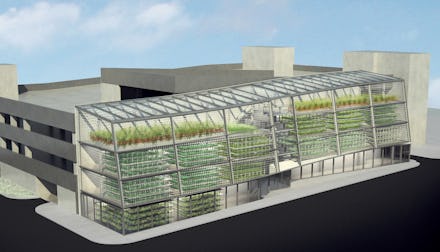This Vacant Lot Is Turning Itself Into a Farm of the Future

It's a vacant lot no more than one-tenth of an acre in downtown Jackson, Wyoming. But soon it will be one of the world's first vertical farms, a three-story greenhouse that uses conveyor belts and green technology to produce five acres' worth of produce.
Vertical Harvest could be the future of agriculture, growing crops 24/7 in a controlled indoor environment. Decades from now, similar urban farming projects could allow food to be grown pretty much anywhere.
How it works: The entire greenhouse is semi-automated. It uses conveyor belts to move plants around each greenhouse floor and position them to absorb sufficient sunlight from the building's south end throughout the day. On the top level, the conveyors will position plants close to the greenhouse's glass ceiling to create an additional level of lighting.
The project's website explains that the farm will use hydroponics technology (essentially growing the crops in mineral-enriched water rather than soil), which will offset water consumption by 90%, take up one-forth as much room and, in some cases, allow produce to grow twice as quickly. Vertical Harvest also claims that the facility will mainly compete with distant suppliers that ship produce into the Jackson region rather than local suppliers, and that 95% of its projected yield has already been purchased by area grocery stores and restaurants. Co-founders Penny McBride and Nona Yehia told Fast Company that the facility would produce 37,000 pounds of greens, 4,400 pounds of herbs and 44,000 pounds of tomatoes annually.
As Maddie McQueeney, a Vertical Harvest advisory board member, wrote for Live Better Magazine in 2012, this approach offers additional advantages like immunity to weather conditions and next to no use of pesticides or fertilizers. Because goods can be grown locally, shipping costs and spoilage rates will be reduced as well.
The facility will also employ developmentally disabled individuals, which fellow advisory board member Caroline Croft-Estay said would help them earn money, independence and self-confidence, as reported by McQueeney.
Is vertical farming the future? As technology advances, it may be possible to grow large high-quality hydroponic food alongside traditional commercial and residential structures in urban environments. University of Nottingham plant scientist Erik Murchie told the Guardian that by moving food production closer to population centers, cities could dramatically reduce their environmental impact.
"The beauty of vertical farming is that you can go as high as you want, if you have a system that works efficiently," he told the Guardian. "The only risk with that is getting things that plants need like water and nutrients up there. And you need a way of getting your product out efficiently."
Other designs are even more fanciful. In Sweden, the international Centre of Excellence for Urban Agriculture began building a so-called "Plantagon" in 2012:
Purdue University horticulturalist Cary Mitchell, however, thinks the future of vertical farming won't be in building scaled-up Vertical Farm-style attachments to skyscrapers. Instead, he told NPR that vertical farms will likely be located in large, industrial-style warehouses flooded with the red and blue (in which case, purple) LED lights. According to NPR, one Texas-based company named Caliber Biotherapeutics is already doing the same with a 150,000-square-foot "plant warehouse" that looks like this:
In Japan, entrepreneur Shigeharu Shimamura and GE teamed up to create this indoor lettuce farm that Web Urbanist reports is the world's largest, sizing up at "25,000 square feet, producing 10,000 heads of lettuce per day (100 times more per square foot than traditional methods) with 40% less power, 80% less food waste and 99% less water usage than outdoor fields":
With billions more humans expected by 2050, vertical farms of a different varieties could help fill the gaps, allowing people to offset some of their carbon impact by buying local. They could also help ensure food security by allowing crops to be grown year-round at a higher efficiency than traditional farms. But in Jackson, where a freezing climate prevents many kinds of produce from being grown locally, vertical farming could also be useful by simply helping people buy healthy food at reasonable prices.